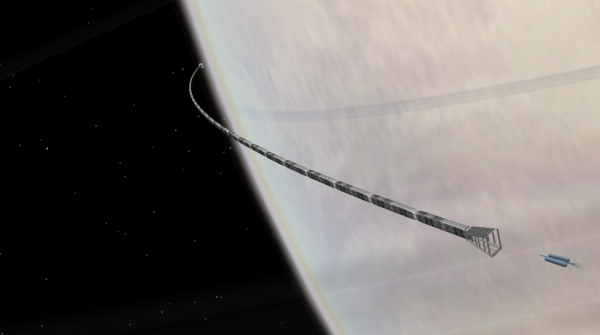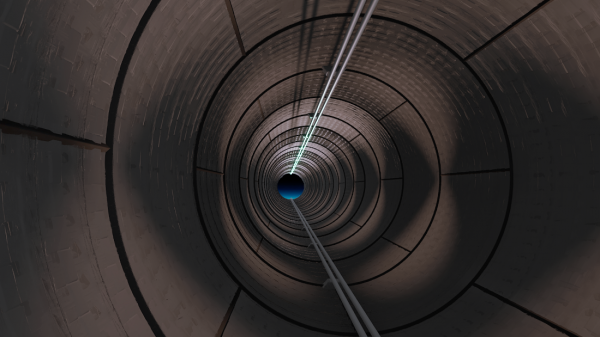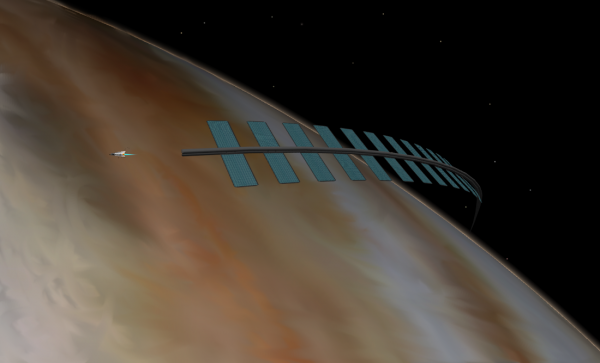BY LETTER
Space Runways
Technology > Application > Megascale Engineering
Technology > Application > Transportation > Surface-To-Orbit Transport
Technology > Application > Transportation > Surface-To-Orbit Transport
Launch assist megastructures | |
 Image from Steve Bowers | |
| A space runway around the planet Adonis, which extracts power from the planet's magnetic field to assist with acceleration and deceleration of payloads. | |
Description
The basic principle behind a space runway is that it is much easier to reach orbital altitude than to reach orbital altitude and orbital velocity. If a spacecraft is lifted up to orbital altitude even temporarily, it can dock with a space runway and then be accelerated by it (using the linear eddy current braking effect) to orbital velocity. This greatly reduces the delta-v requirements for a space launch: for example, a launch that would normally require ~9 km/s of delta-v requires just ~2 km with a space runway. This makes it much easier to achieve fully reusable, single-stage-to-orbit spacecraft, resulting in cheap and convenient space travel.The manner in which a spacecraft docks with a space runway depends on the latter's design. With a ribbon- or rod-shaped runway, the spacecraft surrounds the runway using a tubular or U-shaped structure. With a tubular runway, the spacecraft enters the runway and is accelerated inside it, similar to a vac train.
 Image from Alex Mulvey | |
| The interior of a tubular space runway | |
Space runways are not limited to helping launch spacecraft into orbit. With modifications to the design that allow spacecraft to propel themselves along the runway, they can also serve as acceleration tracks, boosting the velocity of spacecraft further to send them on trajectories towards nearby moons, Lagrange points or other planets. The largest space runways (those that form continuous rings) can boost spacecraft to velocities sufficient for interstellar travel. By decelerating spacecraft to below orbital velocity, they can also assist in landing. Furthermore, space runways can be used as a base to attach satellites to and as a means of transmitting data (via optical fibres) and energy (through superconducting wires) around a world.
Compared to similar launch systems, space runways:
- are smaller than beanstalks, orbital rings (both dynamic and static) or Lofstrom loops, making them easier to construct.
- are purely orbiting structures, so they do not experience as much tensile stress as beanstalks or skyhooks.
- do not depend on active support, removing one potential mechanism of failure.
- can be built incrementally, starting with a short runway that is gradually lengthened (increasing the range of cargo it can transport) and eventually forms a complete ring
- cannot be built from the surface, unlike Lofstrom loops, space fountains or launch ramps, requiring their components to either be launched into space or constructed in space.
- unless they are a complete ring, they do not assist in launching spacecraft to orbital altitude, unlike beanstalks, Lofstrom loops or space fountains.
- unless they are a complete ring, they require a spacecraft to precisely dock with a structure traveling at a much higher velocity (typically multiple km/s higher). While modern technology makes this a safe and reliable process, fear of potential crashes nevertheless prevents use of space runways in certain polities.
Construction
Modern space runways consist of many distinct units that are connected at their ends, which allows modular construction. They include artificial muscle in their composition, which allows them to be launched into orbit as compact spools that then unravel themselves to form the linear runway. Self-repair capability is also common, to handle damage caused by micrometeoroids and space junk. The units also include radio antennae, optical fibres, superconducting wires, solar panels, computronium and other features necessary for their function. The placement of these additional features varies depending on the design: tube designs can have them attached anywhere to the exterior surface of the tube, but ribbon or rod designs must have them attached to the lower surface or to the ends (to avoid obstructing the spacecraft using the space runway). Space runways in bioist polities, such as the Zoeific Biopolity, are made from biological components, e.g. biological muscle rather than artificial muscle and leaves instead of optical fibres.Initial construction involves launching several runway units into low orbit, where they unravel, join together at their ends and become rigid (rigidity being essential for the runway's function). The initial runway typically has a length no greater than 100 km, too short to use for anything but sturdy cargo, as delicate cargo (including living passengers) would be crushed by the intense g-forces while accelerating on such a short runway. However, it can assist the launch of additional runway units and thus the expansion of the runway.
Maintenance
A space runway loses some of its own velocity whenever it accelerates a spacecraft. Conversely, it regains some velocity when it decelerates a spacecraft. To compensate for any differences, and also to compensate for tidal forces, space runways use high-efficiency propulsion (typically powered by solar energy) to maintain their orbital velocity. Space runways around worlds with magnetic fields can use electrodynamic propulsion, while those around worlds lacking magnetic fields instead use ion propulsion. Space runways that form continuous rings can be propelled via motors on their attached skyhooks. Image from Steve Bowers | |
| A Space Runway around Rembrandt, powered by photovoltaic panels. | |
History
The first space runways were constructed around Earth in the second century A.T. These early runways were constructed using heavy-lift rockets, and rockets were also used to deliver payloads to the runways. Plans were underway to construct similar runways around Jupiter and Saturn: these planets had strong magnetic fields that facilitated operation of space runways, and their deep gravity wells created a need for such infrastructure. But these plans were ended by the Technocalypse, which also destroyed the runways around Earth.Since then, space runways have been used throughout Terragen civilization as one of many pieces of space infrastructure. They are especially useful around worlds with slow rotation or no solid surface, where beanstalks would be impractical or outright impossible. Modern space runways are constructed using lunar or asteroidal materials, or materials launched from the surface using mass drivers. In their incomplete form, they are serviced using suborbital spaceplanes (for delicate cargo; these typically deliver transport capsules to space runways rather than docking with the runways themselves) or the same mass drivers (for sturdy cargo).
Related Articles
- Launch Ramp
- Lofstrom Loop
- Lorrey Loop - Text by Steve Bowers
Advanced form of Lofstrom Loop using three geostationary terminii in orbit at the points of an equilateral triangle, and three ground terminii opposite them, connected by a stream of vessels or particles which travel in Hofmann orbits (except when in the atmosphere), thereby saving energy. - Mass-Stream Technology (Space Fountains and Orbital Rings)
- Rotovator
- Skywheel
- Vac Trains
Appears in Topics
Development Notes
Text by Tardigrada
Initially published on 12 February 2021.
Initially published on 12 February 2021.






